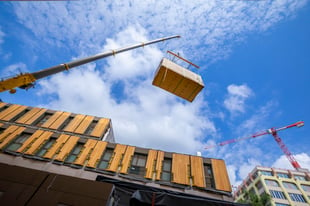Modular Construction During the Preconstruction Process
Should preconstruction departments get ready for a prefab boom in 2025?
According to the Modular Building Institute, prefab modular construction grew over 6% in 2023. And it is estimated that modular and prefab construction will increase to $120 billion globally by 2027.
There are highly desirable proven benefits of using prefab construction:
- Less waste production —up to 83.2% in overall waste weight reduction to be exact.
- Speed up project timelines by up to 50%. DESTINI Estimator users Marriott International completed projects 50% faster using prefab.
- Safer environment for workers
- Higher quality control over materials
- It can solve the labor shortage challenge
- DESTINI Estimator client Brasfield & Gorrie shifted over 26,708 labor hours off-site during the build of HCA Florida University Hospital.

- DESTINI Estimator client Brasfield & Gorrie shifted over 26,708 labor hours off-site during the build of HCA Florida University Hospital.
Anirban Basu, chief economist for the Associated Builders and Contractors, says, “Given the shortage of skilled construction workers in much of America, and the preference for employees to work in controlled settings, modular construction’s ongoing emergence is virtually assured.”
Plus, with shorter project timelines, owners are seeing their return on investment quicker—a considerable factor when winning repeat work. And the demand to build more sustainably is also attractive to owners. This combined with prefab could be a partial solution to the labor shortage in construction. The predictions for modular construction growth seem logical. But prefab still has its challenges. And precon plays a crucial role in overcoming those challenges.
- Getting buy-in from the designer and locking in dimensions early.
- Does prefab logistically make sense for the project’s location?
- Which interior parts can be prefabricated?
- Estimating the costs of site differences.
Stewart Carroll, Chief Customer Officer at Beck Technology, says, “You can’t cookie cutter the site.” Even though some modular construction can be template-based, each project site has its own unique differences. Building codes, labor costs, etc., cannot be templated.
So, what can preconstruction do to prepare for more modular construction?
Stewart predicts that “prefab will go in places where you don’t necessarily see it.” The overall size of the building can change, but for things like duct work, mechanical elements, and internal walls, anything that is modular, can be where preconstruction makes cost-savings project decisions.
Prefab and modular construction can add value to a project if you can figure out where that value is. Carroll says, “Those who can figure it out incrementally are the ones who will win.”
Lock in and get ready. The preconstruction process will make a dramatic difference in prefab and modular construction in 2024.

-1.png?width=112&height=112&name=image%20(4)-1.png)














